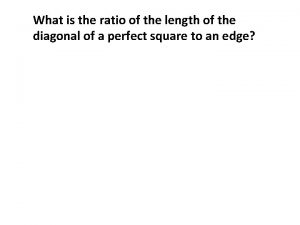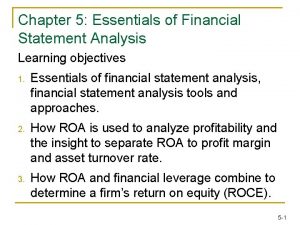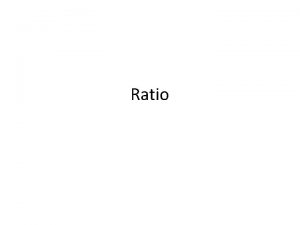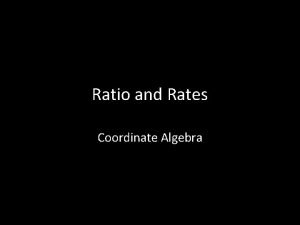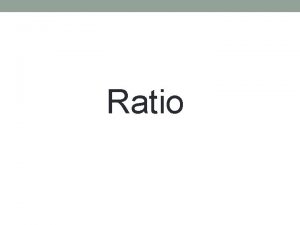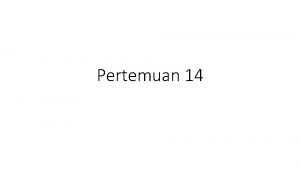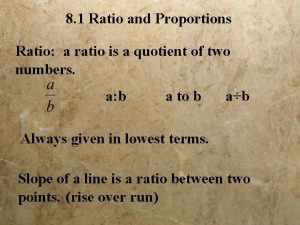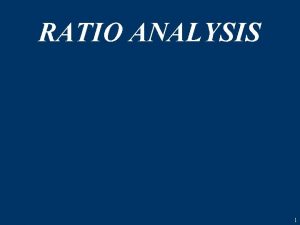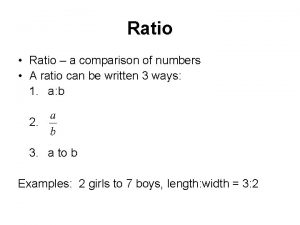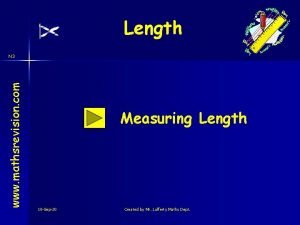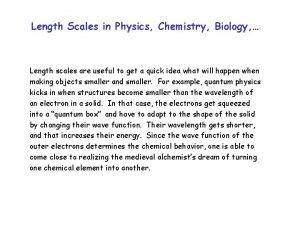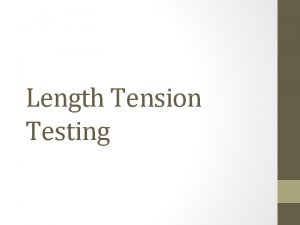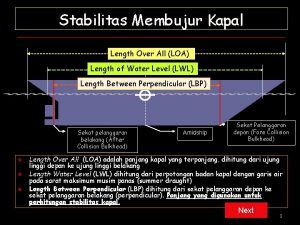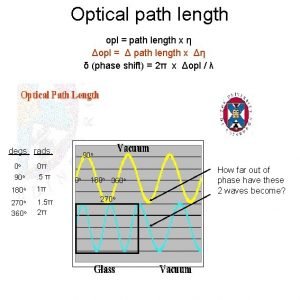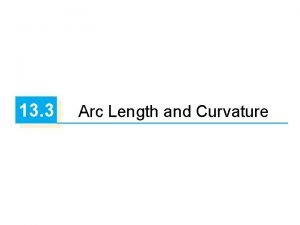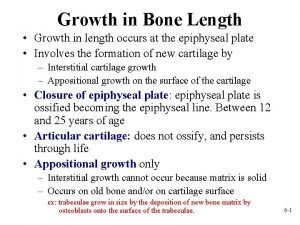What is the ratio of the length of











































- Slides: 43

What is the ratio of the length of the diagonal of a perfect square to an edge?

What is the ratio of the length of the diagonal of a perfect square to an edge?

What is the ratio of the length of the diagonal of a perfect square to an edge? The white area in the top square is (a 2)/2.

What is the ratio of the length of the diagonal of a perfect square to an edge? The white area in the top square is (a 2)/2. So the white area in the lower square is 2 a 2.

What is the ratio of the length of the diagonal of a perfect square to an edge? The white area in the top square is (a 2)/2. So the white area in the lower square is 2 a 2. But this area can also be expressed as b 2.

What is the ratio of the length of the diagonal of a perfect square to an edge? The white area in the top square is (a 2)/2. So the white area in the lower square is 2 a 2. But this area can also be expressed as b 2. Thus, b 2 = 2 a 2.

What is the ratio of the length of the diagonal of a perfect square to an edge? The white area in the top square is (a 2)/2. So the white area in the lower square is 2 a 2. But this area can also be expressed as b 2. Thus, b 2 = 2 a 2. Or, (b/a)2 = 2.

We conclude that the ratio of the diagonal to the edge of a square is the square root of 2, which can be written as √ 2 or 1/2 2.

• So √ 2 is with us whenever a perfect square is.

• So √ 2 is with us whenever a perfect square is. • For a period of time, the ancient Greek mathematicians believed any two distances are commensurate (can be co-measured).

• So √ 2 is with us whenever a perfect square is. • For a period of time, the ancient Greek mathematicians believed any two distances are commensurate (can be co-measured). • For a perfect square this means a unit of measurement can be found so that the side and diagonal of the square both integer multiples of the unit.

• This means √ 2 would be the ratio of two integers.

• This means √ 2 would be the ratio of two integers. • A ratio of two integers is called a rational number.

• This means √ 2 would be the ratio of two integers. • A ratio of two integers is called a rational number. • To their great surprise, the Greeks discovered √ 2 is not rational.

• This means √ 2 would be the ratio of two integers. • A ratio of two integers is called a rational number. • To their great surprise, the Greeks discovered √ 2 is not rational. • Real numbers that are not rational are now called irrational.

• This means √ 2 would be the ratio of two integers. • A ratio of two integers is called a rational number. • To their great surprise, the Greeks discovered √ 2 is not rational. • Real numbers that are not rational are now called irrational. • We believe √ 2 was the very first number known to be irrational. This discovery forced a rethinking of what “number” means.

• We will present a proof that √ 2 is not rational.

• We will present a proof that √ 2 is not rational. • Proving a negative statement usually must be done by assuming the logical opposite and arriving at a contradictory conclusion.

• We will present a proof that √ 2 is not rational. • Proving a negative statement usually must be done by assuming the logical opposite and arriving at a contradictory conclusion. • Such an argument is called a proof by contradiction.

Theorem: There is no rational number whose square is 2.

Theorem: There is no rational number whose square is 2. Proof : Assume, to the contrary, that √ 2 is rational.

Theorem: There is no rational number whose square is 2. Proof : Assume, to the contrary, that √ 2 is rational. So we can write √ 2= n/m with n and m positive integers.

Theorem: There is no rational number whose square is 2. Proof : Assume, to the contrary, that √ 2 is rational. So we can write √ 2= n/m with n and m positive integers. Among all the fractions representing √ 2, we select the one with smallest denominator.

So if √ 2 is rational (√ 2= n/m) then an isosceles right triangle with legs of length m will have hypotenuse of length n= √ 2 m. n = √ 2 m

So if √ 2 is rational (√ 2= n/m) then an isosceles right triangle with legs of length m will have hypotenuse of length n= √ 2 m. Moreover, for a fixed unit, we can take ΔABC to be the smallest isosceles right triangle with integer length sides. n = √ 2 m

Now, for the basic trick. Bisect the angle at A and fold the edge AB along the edge AC.

Now, for the basic trick. Bisect the angle at A and fold the edge AB along the edge AC.

Now, for the basic trick. Bisect the angle at A and fold the edge AB along the edge AC. This creates a new triangle ΔDEC with the angle at E being a right angle and the angle at C still being 45⁰.

Now, for the basic trick. Bisect the angle at A and fold the edge AB along the edge AC. This creates a new triangle ΔDEC with the angle at E being a right angle and the angle at C still being 45⁰. AE=AB=m

Now, for the basic trick. Bisect the angle at A and fold the edge AB along the edge AC. This creates a new triangle ΔDEC with the angle at E being a right angle and the angle at C still being 45⁰. AE=AB=n EC=AC-AE

Now, for the basic trick. Bisect the angle at A and fold the edge AB along the edge AC. This creates a new triangle ΔDEC with the angle at E being a right angle and the angle at C still being 45⁰. AE=AB=n EC=AC-AE=n-m

Now, for the basic trick. Bisect the angle at A and fold the edge AB along the edge AC. This creates a new triangle ΔDEC with the angle at E being a right angle and the angle at C still being 45⁰. AE=AB=n EC=AC-AE=n-m BD=DE

Now, for the basic trick. Bisect the angle at A and fold the edge AB along the edge AC. This creates a new triangle ΔDEC with the angle at E being a right angle and the angle at C still being 45⁰. AE=AB=n EC=AC-AE=n-m BD=DE=EC=n-m

But, if BD=DE=EC=n-m and BC=m,

But, if BD=DE=EC=n-m and BC=m, then DC=BC-BD

But, if BD=DE=EC=n-m and BC=m, then DC=BC-BD=m-(n-m)

But, if BD=DE=EC=n-m and BC=m, then DC=BC-BD=m-(n-m)=2 m-n.

But, if BD=DE=EC=n-m and BC=m, then DC=BC-BD=m-(n-m)=2 m-n.

But, if BD=DE=EC=n-m and BC=m, then DC=BC-BD=m-(n-m)=2 m-n. Since n and m are integers, n -m and 2 m-n are integers and ΔDEC is an isosceles right triangle with integer side lengths smaller than ΔABC.

This contradicts our choice of ΔABC as the smallest isosceles right triangle with integer side lengths for a given fixed unit of length.

This contradicts our choice of ΔABC as the smallest isosceles right triangle with integer side lengths for a given fixed unit of length. This means our assumption that √ 2 is rational is false. Thus there is no rational number whose square is 2. QED

This beautiful proof was adapted from Tom Apostol: “Irrationality of the Square Root of Two: A Geometric Proof”, American Mathematical Monthly, 107, 841 -842 (2000).

This beautiful proof was adapted from Tom Apostol: “Irrationality of the Square Root of Two: A Geometric Proof”, American Mathematical Monthly, 107, 841 -842 (2000). Behold, √ 2 is irrational!
 What is the ratio of the length of to the length of ?
What is the ratio of the length of to the length of ? Fixed interval vs variable interval
Fixed interval vs variable interval Rr statistics
Rr statistics Phenotypic ratio of dihybrid cross
Phenotypic ratio of dihybrid cross Gears mechanical advantage
Gears mechanical advantage Perbedaan or dan rr
Perbedaan or dan rr Acid test ratio and quick ratio
Acid test ratio and quick ratio Current ratio and quick ratio
Current ratio and quick ratio Các châu lục và đại dương trên thế giới
Các châu lục và đại dương trên thế giới Thế nào là hệ số cao nhất
Thế nào là hệ số cao nhất ưu thế lai là gì
ưu thế lai là gì Hệ hô hấp
Hệ hô hấp Tư thế ngồi viết
Tư thế ngồi viết Cái miệng nó xinh thế
Cái miệng nó xinh thế Hình ảnh bộ gõ cơ thể búng tay
Hình ảnh bộ gõ cơ thể búng tay đặc điểm cơ thể của người tối cổ
đặc điểm cơ thể của người tối cổ Mật thư anh em như thể tay chân
Mật thư anh em như thể tay chân Tư thế ngồi viết
Tư thế ngồi viết Thẻ vin
Thẻ vin Gấu đi như thế nào
Gấu đi như thế nào Thể thơ truyền thống
Thể thơ truyền thống Các châu lục và đại dương trên thế giới
Các châu lục và đại dương trên thế giới Từ ngữ thể hiện lòng nhân hậu
Từ ngữ thể hiện lòng nhân hậu Diễn thế sinh thái là
Diễn thế sinh thái là Vẽ hình chiếu vuông góc của vật thể sau
Vẽ hình chiếu vuông góc của vật thể sau Frameset trong html5
Frameset trong html5 Thế nào là giọng cùng tên? *
Thế nào là giọng cùng tên? * Phép trừ bù
Phép trừ bù Lời thề hippocrates
Lời thề hippocrates Sự nuôi và dạy con của hươu
Sự nuôi và dạy con của hươu Thang điểm glasgow
Thang điểm glasgow đại từ thay thế
đại từ thay thế Quá trình desamine hóa có thể tạo ra
Quá trình desamine hóa có thể tạo ra Công thức tính thế năng
Công thức tính thế năng Thế nào là mạng điện lắp đặt kiểu nổi
Thế nào là mạng điện lắp đặt kiểu nổi Các loại đột biến cấu trúc nhiễm sắc thể
Các loại đột biến cấu trúc nhiễm sắc thể Nguyên nhân của sự mỏi cơ sinh 8
Nguyên nhân của sự mỏi cơ sinh 8 Bổ thể
Bổ thể Vẽ hình chiếu đứng bằng cạnh của vật thể
Vẽ hình chiếu đứng bằng cạnh của vật thể Phản ứng thế ankan
Phản ứng thế ankan Các môn thể thao bắt đầu bằng tiếng đua
Các môn thể thao bắt đầu bằng tiếng đua Thiếu nhi thế giới liên hoan
Thiếu nhi thế giới liên hoan Khi nào hổ con có thể sống độc lập
Khi nào hổ con có thể sống độc lập Chúa sống lại
Chúa sống lại
